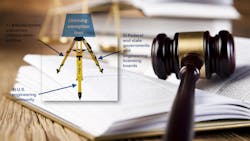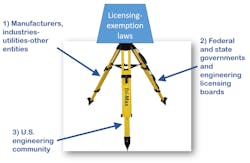Getting Rid of Engineering Licensing-Exemption Law
The first article in this two-part series concluded that the American engineering community’s widespread ethics codes that say public protection is paramount stand in sharp and hypocritical conflict with the equally widespread licensing-exemption laws. If this dilemma stands, the public faces unnecessary risks. We need reform so that competent and accountable professional engineers (PEs) who do place public protection paramount are in responsible charge (i.e., direct control of all substantive project elements) of risky engineering projects.
Reform requires first identifying and understanding individuals and groups supporting licensing-exemption laws. Second, reform must describe how change-minded leaders and organizations could dismantle, or at least weaken, support for those exemptions. Third, individuals and organizations must act.
To use a metaphor, licensing-exemption laws, like tripods, are stable because of the three strong legs supporting them. In the case of the laws, the “legs” are:
- Manufacturers, industries, utilities, and other entities working under the laws that tend to develop bottom line-first cultures.
- Federal and state governments and engineering licensing boards.
- The U.S. engineering community.
“What you do speaks so loudly that I cannot hear what you say.”
—Ralph Waldo Emerson
Let’s consider suggestions for addressing each of these.
For Manufacturers and other Entities
Engineering-intensive entities using licensing-exemptions could take a follow-the-money approach when contemplating costs connected to disasters. One-time costs include staff time, attorney fees, expert’s fees, victim compensation, and fines. Long-term and repeatable costs include liability insurance premiums, personnel turnover, and damaged reputations.
Consider Boeing and its two 737 MAX 8 crashes. In January 2021, the U.S. government announced that Boeing agreed to pay more than $2.5 billion as part of a legal settlement with the Justice Dept. The agreement established a $500 million fund to compensate the families of the 346 people who died in the crashes.
What if, a decade ago, Boeing leaders would have had the foresight to invest a small fraction of $2.5 billion in a more responsible approach to engineering? The company could have established an engineering structure with strategically identified and recruited PEs placed in responsible charge of various aspects of aircraft design and manufacturing.
These competent, ethical, and accountable professionals could have led teams of unlicensed engineers, various specialists, and support personnel to make sure public safety—as well as the bottom line—were appropriately considered. The resulting culture could well have prevented the human, financial, and reputational costs eventually caused by the 737 MAX 8 disasters.
For Governments and Engineering Licensing Boards
All U.S. states plus the District of Columbia (except Oklahoma and Arkansas) have adopted various forms of engineering licensing-exemption laws. In organizations operating under these laws, bottom-line managers and executives tend to make major engineering decisions on risky projects.
This dangerous practice conflicts with a board’s principal responsibility–protecting the public. Licensing boards and state legislatures should proactively provide that protection by removing engineering licensing exemptions. Use the absolute authority granted under Dent v. West Virginia, an 1889 U.S. Supreme Court decision which gave states essentially unlimited power to regulate professions for public-protection purposes.
The Federal Government (e.g., the FAA) could require that certain engineering functions such as aircraft and car design be conducted under the guidance of and with engineering approved by Pes, whose paramount responsibility is public protection. This mandate could be articulated via a federal regulation that would override contrary state law and be consistent with the U.S. Constitution, Article VI, Supremacy Clause.
For the Engineering Community
You may have been surprised to see the engineering community named as one of the three forces supporting licensing-exemption laws. But it has shown explicit support for exemption laws. Here’s a look at members of the engineering community and what they could do to reduce the harmful effects of exemption the laws. (This discussion excludes the National Society of Professional Engineers because that pan-engineering organization has been a welcome leader in opposing these laws.)
“Modern civilization found it necessary to regulate practices of persons whose activities deal with protection of life, health, rights and property. Medicine, law and engineering are entrusted with that responsibility.”
—paraphrased from a statement by Robert B. Steinman, NSPE founder
ABET (formerly the Accreditation Board for Engineering and Technology) accredits engineering bachelor and master programs. It prescribes the criteria for 28 bachelor’s programs, but only two—civil engineering and construction—are required to include licensing in their curricula. Furthermore, public protection is never mentioned by ABET as the paramount responsibility of engineers, especially PEs.
ABET should revise the criteria so that it describes the purpose of engineering licensing and its educational, examination, and experience requirements, and defines public protection as the engineer’s highest duty.
The National Council of Examiners for Engineering and Surveying (NCEES) states that its vision is “to provide leadership in professional licensure of engineers and surveyors through excellence in uniform laws, licensing standards, and professional ethics in order to safeguard HSW (health, safety, and welfare) of the public and to shape the future of professional licensure.”
The Council adopted eight professional policy statements and 37 position statements. Only one of these statements mentions exemptions, and none advocates reducing exemptions for HSW purposes. NCEES should adopt a position statement that addresses the potential harmful effect of exemptions and describes what should be done to offset that effect.
The National Academy of Engineering’s mission includes promoting a vibrant engineering profession and providing advice to the federal government about issues involving engineering. The Academy’s website is virtually silent regarding licensing, and its use of the term “professional engineer” describes any member of an engineering society, not necessarily a PE.
This absence of a licensed-engineer theme within the Academy’s programs seems strange. PEs are prepared to be in charge and responsible for engineering projects that, without guidance by competent and accountable engineers, put the public at unnecessary risk. Why tolerate any policy or program that endangers the public?
The NAE should consider:
- Limiting use of the term “professional engineer” to licensed engineers.
- Urging the federal government to reduce licensing exemptions applicable to its engineers.
- Studying the effectiveness of U.S. engineering, including the adequacy of education and the effect of licensing exemptions, and make appropriate recommendations to academic and practitioner communities.
Discipline-based engineering societies provide forums where engineers gather, with some aimed at improving engineering education, licensing, and practice. Sometimes they stimulate reform. It’s time to do so with licensing exemptions.
Unfortunately, some societies support exemptions. For example, the American Society of Mechanical Engineers recommends “that any person in responsible charge of the practice of engineering be a legally licensed engineer, except where state statutes allow for exemption.” The American Institute of Chemical Engineers affirms “its support of an engineering policy known as the industrial exemption, while continuing to strongly encourage individual engineers to pursue licensure.” In fairness to AIChE, it does express concern over the “lack of uniformity in licensing laws and regulations between jurisdictions,” noting “this creates an unnecessary burden on the engineer and the company.” Looking forward, the Institute also states, “If the overwhelming majority of engineering licensure boards can adopt a streamlined form of reciprocity…AIChE would consider its support of the industrial exemption.”
Based on all of this, engineering societies should reconsider supporting licensing-exemption laws. Societies and the states should also cooperatively address the license mobility issue.
Engineering societies also ought to help prospective and current engineering students understand the pros and cons of employment in the licensing-exemption environment. They likely could use help in making sound decisions consistent with their values and aspirations.
The “pros” could include challenging technical work, a favorable salary and benefits, less responsibility and pressure because the employer makes major decisions and assumes liability, prestige and often job security. That “challenging technical work” and “prestige” could include designing aircraft, creating autonomous automobiles, and drilling for oil and gas.
In contrast, the “cons” may be minimal autonomy, key engineering decisions made by management, and loss of some career and business start-up flexibility because of the lack of an engineering license. Later, engineers may regret trying to change engineering decisions that put the public at risk and failing or—worse yet—seeing such situations develop and not doing anything about it.
“We have met the enemy and he is us.”
—Pogo, comic strip creation of Walter Kelly
Individual engineers should share experiences and results of research with other engineers. However, talking among ourselves is not enough. Engineers should also write to, speak to and interact with the public.
When doing that, be aware of the prevailing public-perception paradox. Surveys and experience reveal that the American public holds engineers in high regard. In sharp contrast, the public is unaware of the way omnipresent engineering licensing-exemption laws deny them the protection they deserve. That’s where you and I could weigh in. The late Richard Weingardt, PE, said, “The world is run by those who show up.” We need to “show up” more in the public arena.
When we communicate with the public, let’s “work in” topics such as the unnecessary risks imposed by exemptions and the need to have PEs in charge of projects that put the public at risk. How can we “show up?” Weingardt suggested the following four broad areas of community involvement:
Civic organizations: Chambers of Commerce, homeowner’s associations, planning boards, service clubs, historic preservation boards and ad hoc task forces.
Educational organizations: School boards, college or university advisory boards, and students and faculty groups.
Public communication: Op-eds, letters to the editor, news releases, talk shows and blogs.
Politics: Candidate support, candidates, caucuses, and communication with state and federal legislators.
Engineers need to close the gap between what our codes say (“public protection is paramount”) and the bottom-line rules encouraged by licensing-exemption laws.
Now is the time to act.
Stuart G. Walesh, Ph.D., P.E., Dist.M.ASCE, F.NSPE, an independent consultant, teacher and author, holds civil engineering degrees and previously worked in the business, government and academic sectors. He provides engineering, management, leadership, and education services. His most recent book, on which this article draws, is Engineering’s Public-Protection Predicament, 2021. Visit his website or contact him via email.
About the Author
Stuart G. Walesh
Independent consultant, teacher and author
Stuart G. Walesh, Ph.D., P.E., Dist.M.ASCE, F.NSPE, an independent consultant, teacher and author, holds civil engineering degrees and previously worked in the business, government and academic sectors. He provides engineering, management, leadership and education services. His most recent book is Engineering’s Public-Protection Predicament (2021).

